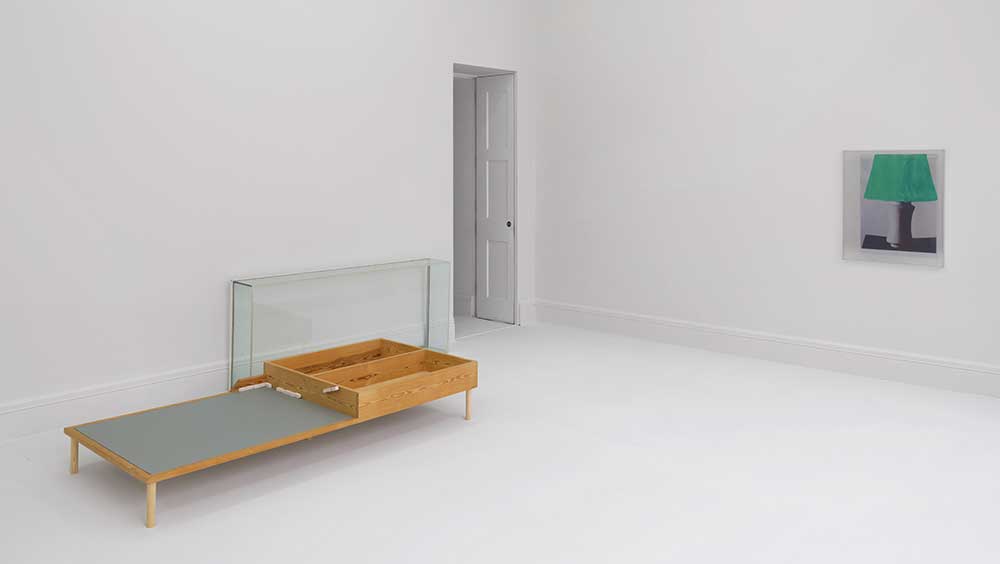
Thea Djordjadze, framing yours making mine, installation view, Sprüth Magers, London, 23 February – 28 March 2024. © Thea Djordjadze / VG Bild-Kunst, Bonn 2024. Photo: Ben Westoby.
Sprüth Magers, London
23 February – 28 March 2024
by VERONICA SIMPSON
Thea Djordjadze is an artist who takes site specificity to new levels. Every show she stages involves an intense week or two-weeks in which the artist – with a container-load of pre-selected, pre-shipped works at her disposal – moves around the gallery spaces placing paintings and sculptures in just such a way as to release the “genius loci” of a building, making changes not just to the work’s positioning but also to wall, window and floor treatments, right up to the opening.
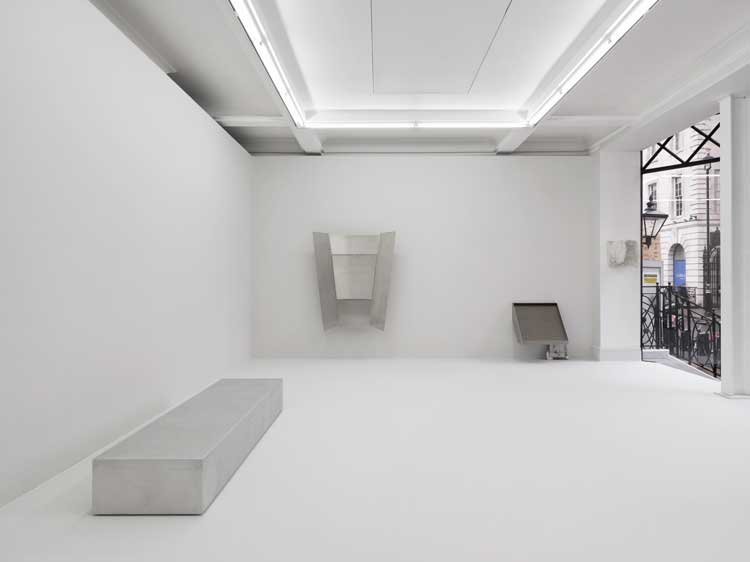
Thea Djordjadze, framing yours making mine, installation view, Sprüth Magers, London, 23 February – 28 March 2024. © Thea Djordjadze / VG Bild-Kunst, Bonn 2024. Photo: Ben Westoby.
Her current Sprüth Magers show is a case in point. This handsome, Regency building has had its main ground floor gallery’s original timber boards obscured by a temporary, canvas-covered platform, the surface has been rendered the same matte, off-white colour as the walls and ceilings, so that the assorted works arranged here appear to float in space. A long, upholstered “ladder”-like piece is draped at a low angle across the floor, its upper edge curving around the edge of the platform towards the floorboards, just visible below.
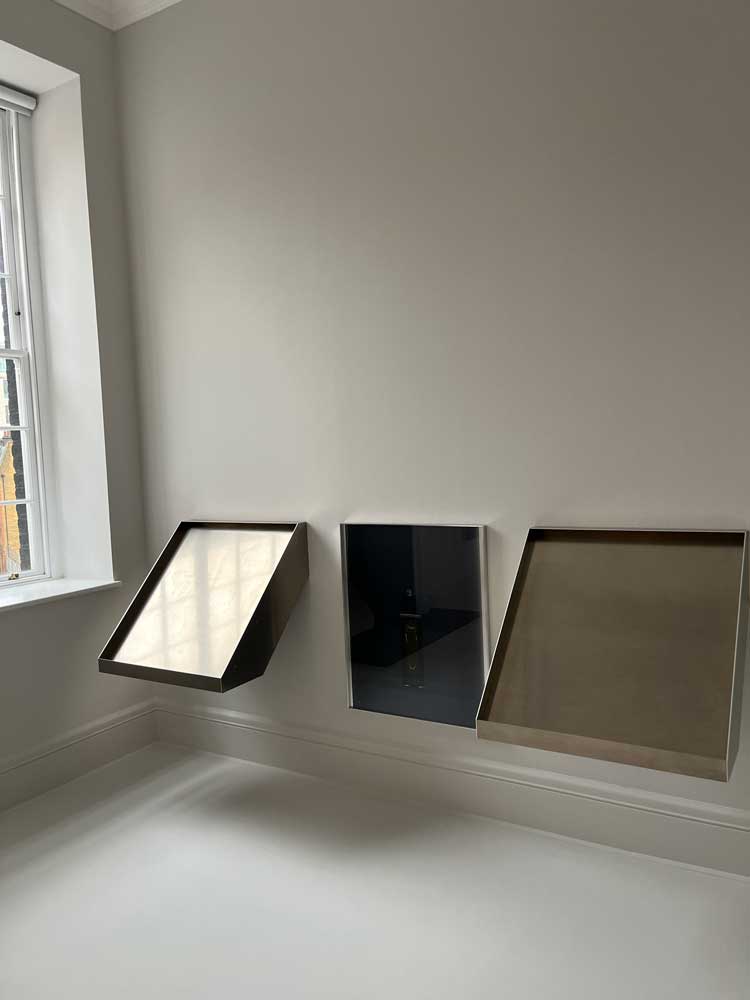
Thea Djordjadze, framing yours making mine, installation view, Sprüth Magers, London, 23 February – 28 March 2024. Photo: Veronica Simpson.
Two sanded-steel trays protrude low down on the wall, tilted towards the visitor, reminiscent of air vents or cutlery drawers, but offering up their empty, tilting interiors for our gaze (one of these ends up being removed for the final hang). A plaster cowl framing empty space floats at head height beside the window, while a slender, polished aluminium box (which could as easily be a coffin as a bench, although the height is too low for the latter) is placed a foot away from the inside wall, to make it clear this is an object, not a resting place. Perched behind one of the downward slanting metal trays is a crisp, white shirt, folded and encased in what looks like chicken wire.
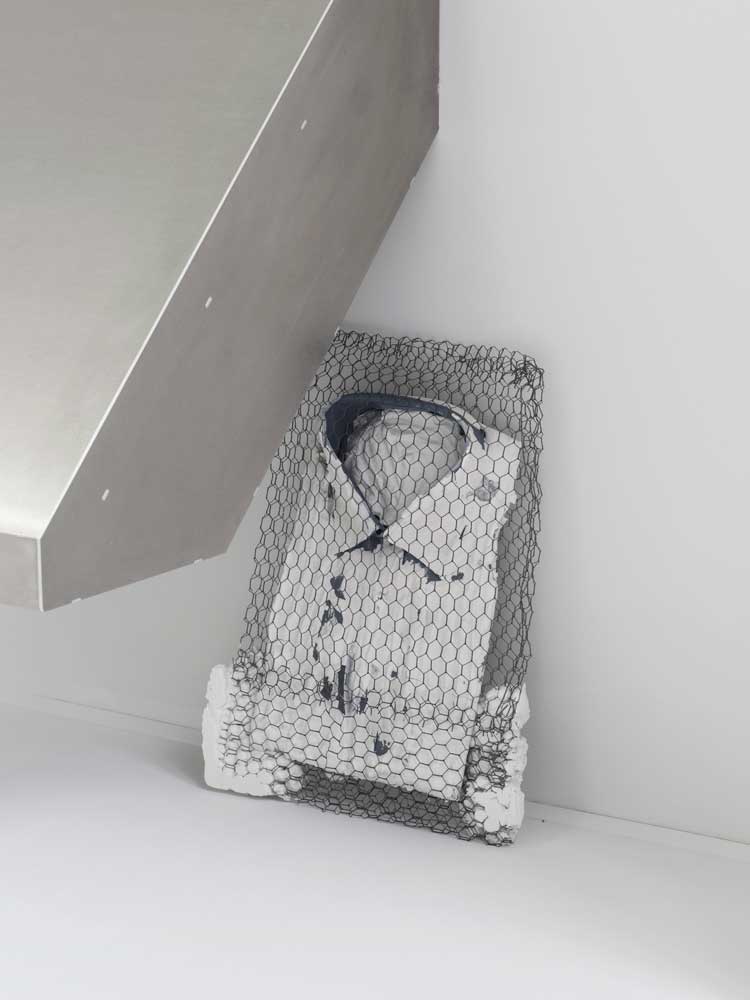
Thea Djordjadze, framing yours making mine, installation view, Sprüth Magers, London, 23 February – 28 March 2024. © Thea Djordjadze / VG Bild-Kunst, Bonn 2024. Photo: Ben Westoby.
With works that occupy some unnameable position, in the Venn diagram that connects sculpture, furniture, painting and installation, it seems a sense of disconnection, disruption and dislocation is what Djordjadze is after. Her pre-show preparations are all about discovering that sweet spot between familiarity and strangeness. During the installation, she tells me: “By changing and trying and moving, you wait until you have this tension between the building, object, painting. It’s one special tension and then everything fits together. I cannot visualise it. You try and try and try until this tension is there. And then you know it has to be this way: you cannot change it.”
Djordjadze’s vision is total, and her attention to detail verges on the obsessive. When I arrive – 24 hours before the opening – she is halfway down the stairs towards the basement, smearing paint on to a window, even though no gallery visitor is likely to pass that way. Her reasons? Simply to control what is reflected in two huge, mirror-polished steel panels that sit at ground-floor level, facing the ornate metalwork of the lift. You could almost miss these glossy panels, mistaking them for a glamorous interior design intervention, but one of them is lifting away from the wall, gently curving like the pages of a well-thumbed book.
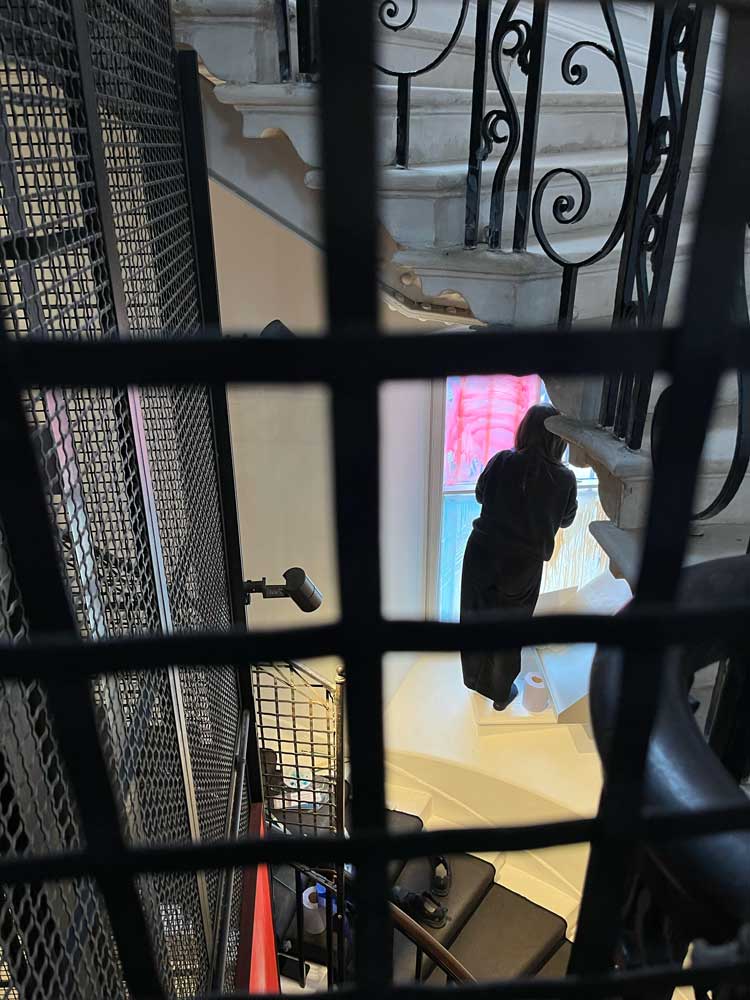
Thea Djordjadze painting the window in the staircase, Sprüth Magers, London. Photo: Veronica Simpson.
She explains: “The windows are so present here and it’s all about transparency and reflection. I’m just taking with me the parts of the building I want to have even though people are not supposed to go down these stairs. I need the whole exhibition to be one take, total.” Admittedly, the view she is obscuring, with blue, yellow and red paint, is a particularly unappealing vista on to an enormous, excavated hole next to this prime piece of Mayfair property.
The view or light levels coming through windows, the presence, quantity and quality of artificial lighting, everything is precisely controlled in each room. The second gallery behind the amply daylit first one has no natural light and only one overhead light. In here, a series of lightweight, steel “shutters” are arranged horizontally around two walls, their flat, layered presentation evoking a safe, a cell or a strongroom. But beside them floats a “tent”, an inverted sheet of the thinnest steel, splayed (Bambi-like) on spindly legs with one vital corner leg missing. Offering neither shelter nor comfort, its silvery surfaces are softly animated by hints of colour drawn from things reflected in the room.
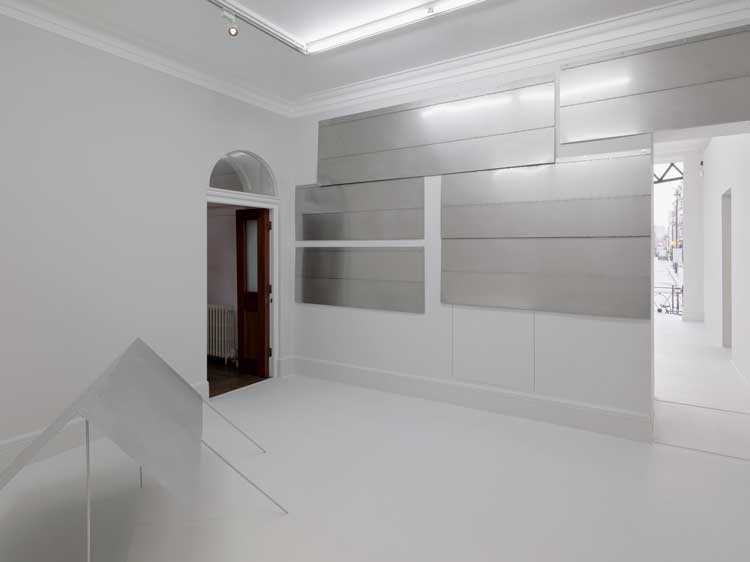
Thea Djordjadze, framing yours making mine, installation view, Sprüth Magers, London, 23 February – 28 March 2024. © Thea Djordjadze / VG Bild-Kunst, Bonn 2024. Photo: Ben Westoby.
This is the most comprehensive selection of works from Djordjadze we have seen in London, with pieces from 2009 to 2023. The aforementioned crinkled, faceless cowl (Voiceless Wailing, 2009) is the earliest, and was shown with many other fragile plaster pieces, arranged across the floor at Kunsthalle Basel in 2009. The tilted metal trays in the same gallery are from 2023. They are called Untitled, as are many of Djordjadze’s later individual works.
-Pic-V-Simpson.jpg)
Thea Djordjadze, Voiceless Wailing, 2009. Installation view, framing yours making mine, Sprüth Magers, London, 23 February – 28 March 2024. Photo: Veronica Simpson.
Djordjadze studied painting first in Georgia, then in Amsterdam and then at the Art Academy of Düsseldorf, where she encountered Rosemarie Trockel. And then, she says: “I stopped painting and changed to her class. And this was very interesting because then painting came into the space. It wasn’t directly sculpture … Composition wise, I started to think about the space as a painting, but I wanted to go further so somehow it became more three-dimensional, reacting into the space (in the same way) as I would react on the canvas. I treat space as a big canvas.”
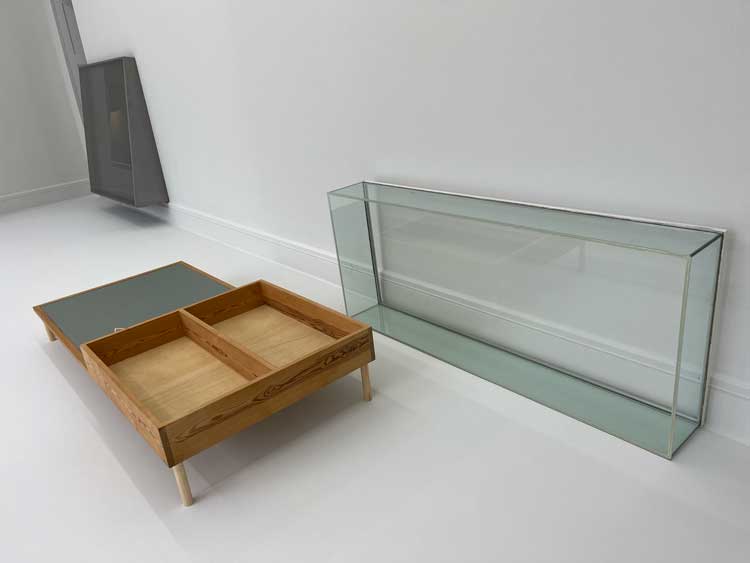
Thea Djordjadze, framing yours making mine, installation view, Sprüth Magers, London, 23 February – 28 March 2024. Photo: Veronica Simpson.
In the upstairs galleries, there are works that sit more conventionally within a wall frame – fascinating collages of materials and images that play with perspective, such as one featuring a table lamp with a vivid green shade. They have a strong graphic and material presence, bringing the odd splash of colour into what is an otherwise very muted selection. In the first upstairs gallery what looks like a classic G Plan display cabinet lies on its back, empty of contents, one side featuring a chalk board in pale grey/green. It is sometimes hung on the wall, I’m told, but here it is floor-bound, supported on spindly wooden legs. Beside it, propped up against a wall is a glass frame that looks as if it should fit snugly on to this cabinet, protecting its putative contents, though the only “contents” in this ensemble are some squares of white chalk, secured to the chalkboard frame by wire.
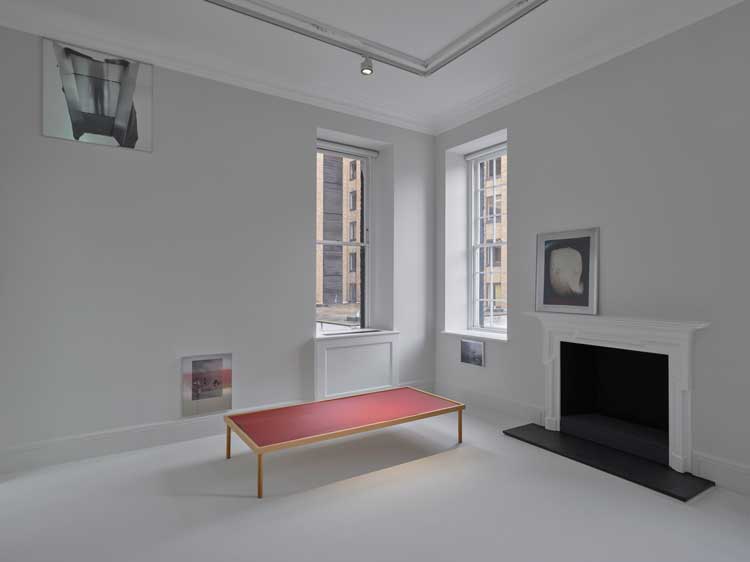
Thea Djordjadze, framing yours making mine, installation view, Sprüth Magers, London, 23 February – 28 March 2024. © Thea Djordjadze / VG Bild-Kunst, Bonn 2024. Photo: Ben Westoby.
Another furniture-like piece sits in the room behind, again a spindly-legged floor piece that could be a table, except that its surface comprises a long strip of red lino that folds gently in the middle – rendering it less than useful.
The gallery’s interior spaces and all the works in it are grouped under the title “Framing Yours Making Mine”. She says: “Is it sculpture? Is it painting? is it installation? It’s all those together. Now the building is more important than the object for me. I go to the spaces, investigate the building. It happens naturally now. The building takes over the object, the sculpture, the painting and they become part of it, part of what the building is making.”